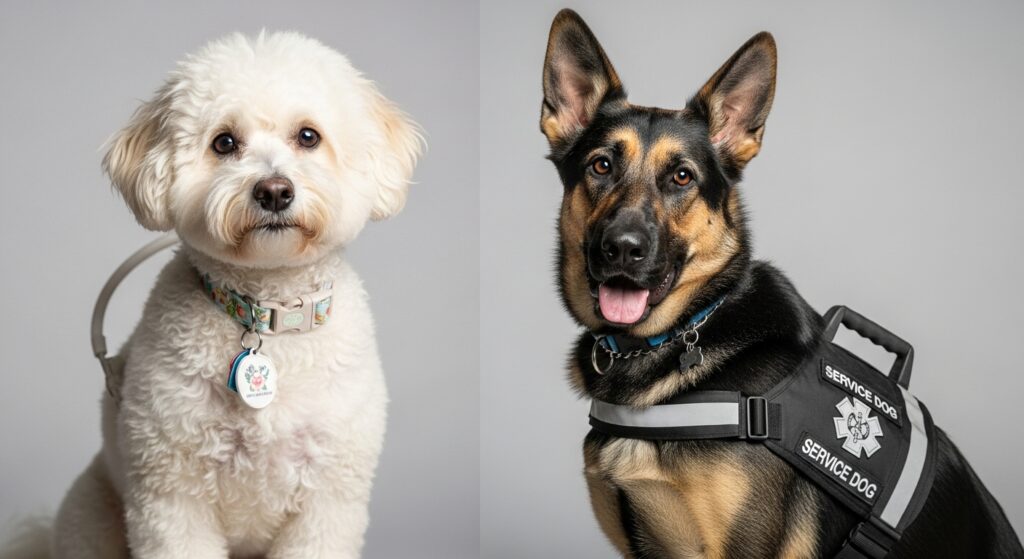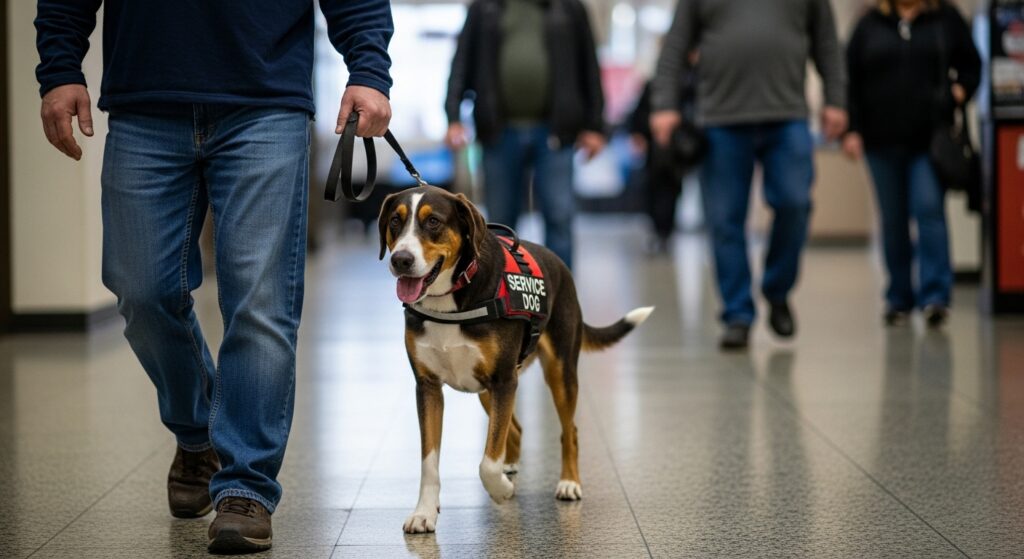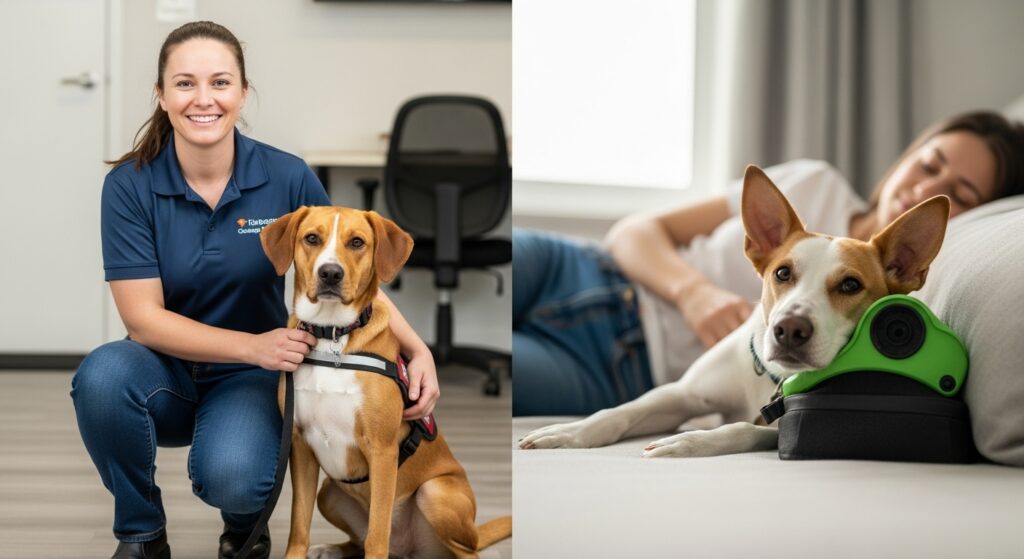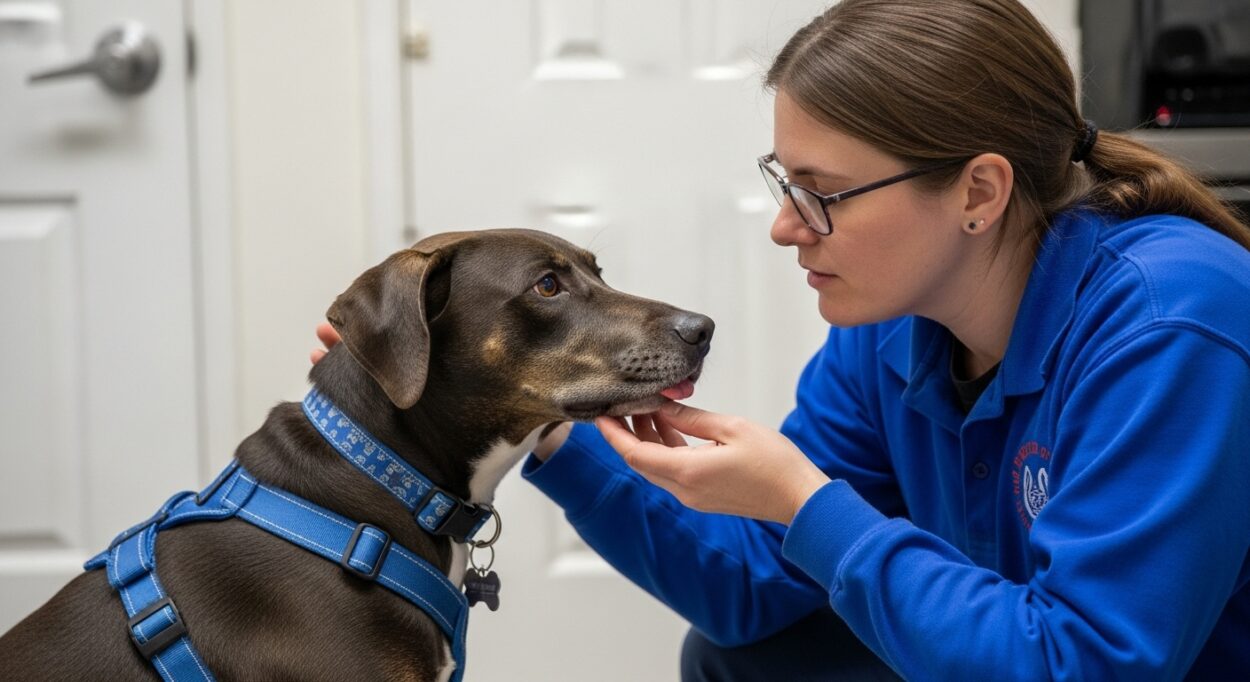Table of Contents
Introduction
If you’re exploring the world of assistance animals, you might have questions about the differences between an emotional support animal (ESA) and a service dog. While these terms are often used interchangeably, they’re actually very different in both their roles and the rights they have under the law.
Understanding the key differences between ESAs and service dogs is crucial—especially if you’re thinking about getting one, need documentation for travel or housing, or just want to know your rights. In this guide, we’ll break down the responsibilities, qualifications, and legal standing of both types, so you can make the best decision for your needs in 2025 and beyond.

What is an Emotional Support Animal (ESA)?
An emotional support animal (ESA) is any pet—most often a dog or cat—that provides comfort and emotional support to someone with a mental or emotional health condition. ESAs are not required to have any special training related to a disability, and their main job is to simply provide companionship and reduce symptoms of anxiety, depression, PTSD, or other issues.
- Who qualifies for an ESA?A person with a diagnosed mental or emotional disability, as determined by a licensed mental health professional who can write a valid ESA letter.
- Types of animals allowed:Dogs, cats, and sometimes other animals (rabbits, birds, etc.), depending on what best fits the individual’s needs.

What is a Service Dog?
A service dog is specially trained to perform specific tasks that help a person with a disability. These tasks are directly related to their handler’s disability and might include:
- Guiding someone who is blind,
- Alerting someone with hearing loss,
- Providing deep pressure therapy for anxiety attacks,
- Retrieving items or helping with mobility,
- Alerting to seizures or diabetic crises, and more.
- Who qualifies for a service dog? Anyone with a documented physical, sensory, psychiatric, or intellectual disability, and whose quality of life would be improved by a dog’s trained tasks.
- Types of service dogs: Most commonly dogs, as they are recognized by the ADA (Americans with Disabilities Act), though miniature horses are allowed for some types of tasks.

Key Differences: ESA vs Service Dog
| Feature | Emotional Support Animal (ESA) | Service Dog |
| Training Required | No specific training needed | Must have specialized training |
| Legal Protections | Fair Housing Act (housing only) | ADA (public access + housing) |
| Public Access | No right to enter non-pet-friendly places | Yes: Allowed in most public places |
| Type of Animal | Any (dog, cat, small animals, etc.) | Almost always dogs |
| Handler’s Requirement | Verified emotional/mental health disability | Verified disability (any kind) |
| Document Needed | ESA letter from a licensed mental health pro | Recommendation + proof of training |
| Task Training | Not required | Required (must perform disability tasks) |
| Air Travel Rights (2025) | Most airlines no longer accept ESAs | Service dogs allowed (follow airline guidelines) |
| Behavioral Standards | Must behave appropriately | Strict standards for behavior/obedience |

Legal Rights: Where Can Each Go?
Emotional Support Animals (ESAs)
- Housing: Protected under the Fair Housing Act; landlords must allow ESAs with a valid letter, even if they normally have a “no pets” policy.
- Travel: Recent airline regulations (including the DOT 2021 rule) no longer require airlines to accept ESAs in the cabin. Most treat them as pets.
- Public Spaces & Workplaces: Generally not allowed unless pets are welcome.
Service Dogs
- Housing: Protected—must be allowed in almost all rental and owned properties.
- Travel: Can fly with their handlers on airlines (documentation may be required).
- Public Spaces: Fully allowed in places where the public can go (restaurants, stores, hotels, etc.) due to the ADA.
Who Should Get an ESA? Who Should Consider a Service Dog?
- Consider an ESA if:You need emotional support, companionship, and symptom relief, but don’t require your animal to perform tasks related to your health.
- Consider a Service Dog if:You have a disability and would benefit from a dog that can be trained to perform specific, life-assisting tasks.

Common Myths—Busted!
- “Any dog can be a service dog if you just buy a vest.”False! Service dogs require months or years of training and can be asked to leave if they misbehave.
- “My landlord has to accept my ESA and service dog the same way.”False! Service dogs have broader rights, but ESAs are still protected for housing with a valid letter.
- “I can take my ESA anywhere I want if I have a letter.”False! Only service dogs have public access rights.
Frequently Asked Questions (FAQ)
Q: Can an ESA become a service dog?A: Yes, if the animal is a dog (or rarely, a miniature horse) and receives extensive training to do specific tasks related to your disability.
Q: Is it legal for someone to ask for proof of my animal’s status?A: For service dogs, staff can only ask if the dog is a service animal required for a disability, and what tasks it’s trained to perform. For ESAs, only housing providers can require an ESA letter.
Q: Do ESAs have any public access rights?A: No. Aside from housing, ESAs do not have rights to enter restaurants, stores, workplaces, or hotels that don’t allow pets.
Q: What kind of documentation do I need for an ESA?A: A signed letter from a licensed mental health professional stating your need for an ESA.
Q: Are online “registries” for ESAs or service dogs legit?A: Most are not. The important documents are a valid ESA letter (for housing) or proof of training/credentials (for service dogs).
Conclusion
Deciding between an emotional support animal and a service dog comes down to your needs, the type of support you require, and your lifestyle. Both bring comfort and stability—but only service dogs are trained for specific tasks and get full public access under the law.
Always use trusted sources, stay up-to-date with the latest rules, and talk to a healthcare or disability professional for tailored advice.







